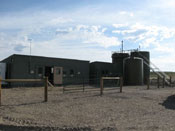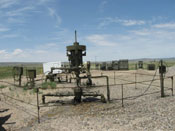Beneficial Use Matrix – Aquifer Recharge, Storage, and Recovery (Class V Well)
Aquifer recharge and aquifer storage and recovery (ASR) methods are used for replenishment of aquifers for subsequent use. Aquifer recharge wells are used for replenishment of water in aquifers only, and ASR wells are used to achieve two objectives: (1) storing water in the ground; and (2) recovering the stored water (from the same well) for a beneficial use. Both methods may have secondary objectives, including subsidence control and prevention of saltwater intrusion into fresh water aquifers.
CBM produced water can be used for aquifer recharge or ASR. A rule authorization for shallow well disposal systems/wells can be issued to facilities if the Underground Injection Control (UIC) program director believes the fluids are not likely to adversely impact Underground Sources of Drinking Water (USDWs). However, if CBM produced water may potentially endanger USDWs or if the impact of the fluids on USDWs is uncertain, a permit may be required.
Colorado and Montana
In the states of Colorado and Montana, the EPA Region 8 directly implements the UIC program in accordance with applicable sections of 40 CFR for all injection well classes other than Class II wells, except on Indian Lands where EPA also implements the Class II UIC program. According to a UIC Program Expert with the EPA, "Fluids being injected into a Class V well must meet Maximum Contaminant Levels (MCLs) as defined by the EPA’s National Primary Drinking Water Standards unless otherwise noted in a UIC permit. However, this does not apply to exempt aquifers."
New Mexico
The New Mexico Water Quality Control Commission has primacy over the UIC program for Class V injection wells under the authority of the Water Quality Act, NMAC. Class V injection wells must meet the requirements of Sections 20.6.2.3000 through 20.6.2.3999 NMAC and Sections 20.6.2.5000 through 20.6.2.5006 NMAC. The water quality standards for the protection of ground water of 10,000 mg/l TDS concentration or less can be found on the State website.
Utah
The Utah Department of Environmental Quality (UDEQ) has primacy over the Class V UIC program, and the US EPA Region 8 directly implements the UIC program in accordance with applicable sections of the 40 CFR for all injection well classes on Indian Lands. For Class V wells, if at any time the Executive Secretary determines that a Class V well may cause a violation of primary drinking water rules under R309-200, the Executive Secretary shall:
- require the injector to obtain an individual permit;
- order the injector to take such actions, including closure of the injection well, as may be necessary to prevent the violation; or
- take appropriate enforcement action.
Whenever the Executive Secretary determines that a Class V well may be otherwise adversely affecting the health of persons, the Executive Secretary may require such actions as may be necessary to prevent the adverse effect. The full Utah water quality rules are available on the State website.
Wyoming
In the State of Wyoming, CBM produced water is appropriate for disposal into a Class V well, as long as the injection is a non-commercial venture. Commercial disposal of CBM produced water is classified as Class I.
Chapter 16 [PDF] of Wyoming Water Quality Division’s rules and regulations contains requirements that must be fulfilled by the injection well owner/operator in order to obtain the necessary UIC permit to construct and operate a Class V CBM produced water injection well. The requirements are intended to ensure that the injection of produced water into the subsurface will not degrade the quality of water within the injection zone; migrate into and degrade water bearing zones above and below the injection zone; or, migrate to the surface via other wells within the area of influence of the injection well.
In general, Class V well injections should not pollute USDW to levels higher than the MCLs specified in EPA’s National Primary Drinking Water Standard found in 40 CFR 141 [PDF] (as of June 6, 2001), or found in Chapter 8 [PDF], Wyoming Water Quality Rules and Regulations, whichever is more stringent. Chapter 8 describes the Quality Standards for Wyoming Groundwater. Groundwater of the state are classified in order to apply standards to protect water quality.

